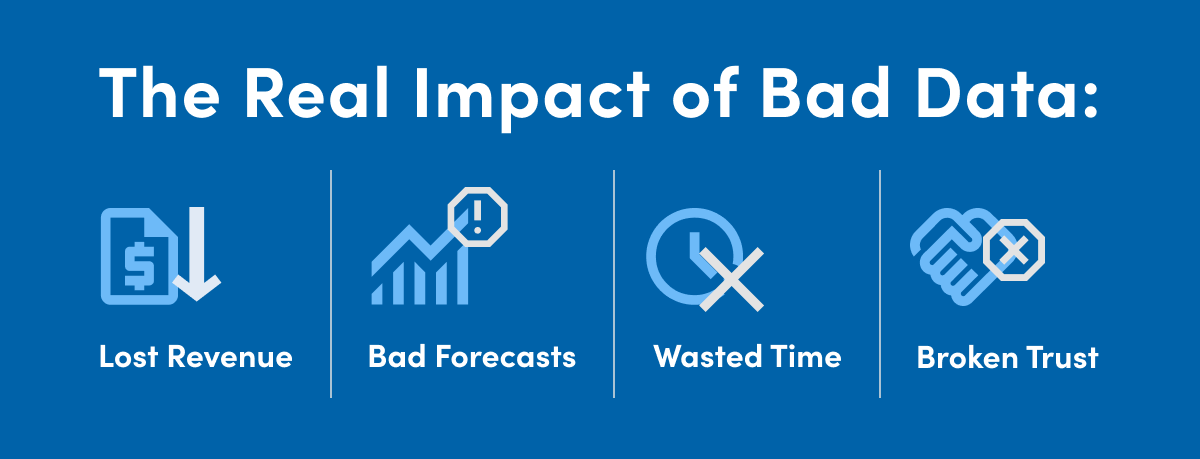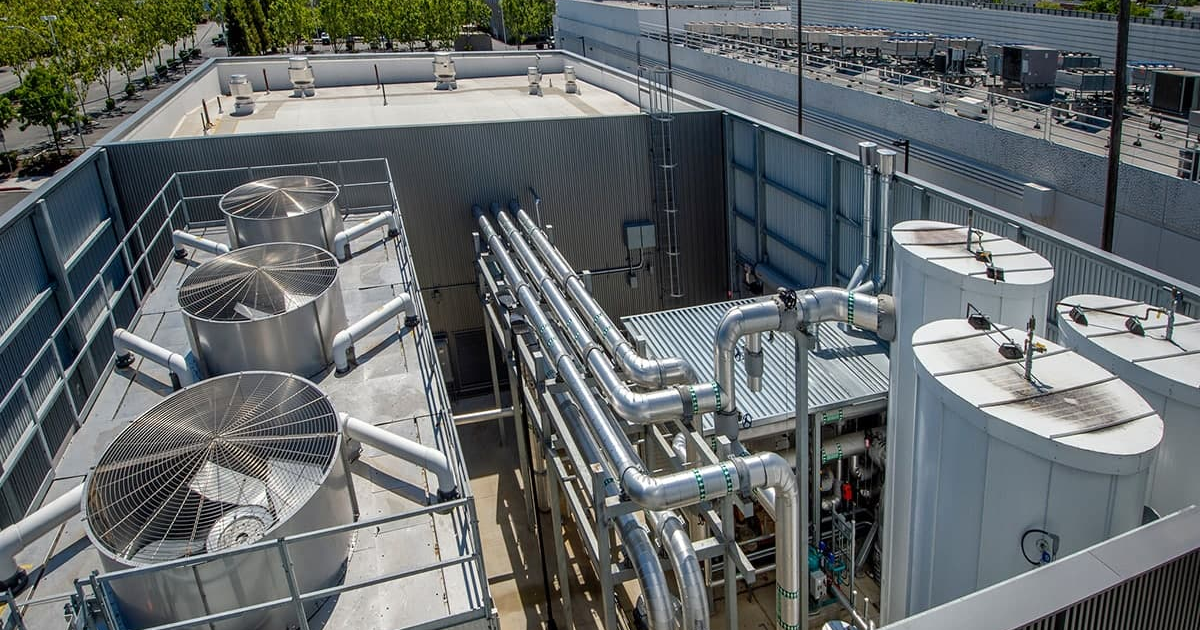Introduction: The Deals You Never Knew You Lost
Imagine your sales team spends hours chasing a lead, only to find out the contact left the company last year but hasn’t updated their profile yet. Or worse, the building you’re looking at is investor-owned and run by a management group several states away. Multiply that by dozens of reps, across several territories, and suddenly you’ve got a hidden leak draining your entire pipeline.
The reality is, this is happening every day - and it’s stealing time and revenue from your company.
Bad data isn’t just annoying—it’s expensive. It clogs your CRM with “ghost records” and unqualified leads, wastes hours of sales reps’ time, and tanks close rates, which hurt quarterly goals. But because these losses are quiet and spread out, leadership rarely sees the true cost.
They just ask the team to work harder, prospect more, and make more cold calls to generate appointments.
In this article, we’ll walk through:
Why commercial services teams are especially vulnerable to bad data
How traditional prospecting methods make the problem worse
What a modern, data-first workflow looks like
And how companies use tools like sales insights and property intelligence to clean up their pipeline—and unlock serious ROI
Let’s get into it.
What Is Bad Data and Why Is It Everywhere in Commercial Services?
If you sell software, you sell to a team (or an organization). If you sell commercial services, you sell “into” a property. That means your reps need more than just names and job titles—they need to understand the property itself.
But here’s the problem:
There are only a few platforms out there that actually combine property intelligence (square footage, permits, equipment) with sales intelligence (decision-makers, organizational charts, ownership information, etc.). So, most sales teams are left stitching together data from legacy CRMs, outdated lists, and public databases - some of which haven’t been updated in years.
That’s how bad data creeps in.
If you’ve been in the industry for a while, you’ve seen it before:
A contact who left the company 6 months ago
A “qualified” lead that turns out to be a property you can’t service
A building marked as under renovation that’s been completed for two years and needed your help back when the buildout was completed
Duplicate records that waste rep time and inflate pipeline numbers
Individually, they all seem like small leaks. But at scale? They distort your entire go-to-market motion and waste hours of rep time per week.
Why It’s Worse in Commercial Services
Most lead generation platforms, intelligence tools, and CRMs weren’t built for property-level selling. And the data you actually need—permit history, square footage, building use, tenant breakdown, owner/operator contact info—isn’t sitting in one place. It’s scattered across fractured tools that are difficult to access.
So, reps are left to build their own territory intel from scratch. They drive for dollars. They Google. They search LinkedIn. They guess. They waste hours on leads that were never real to begin with.
The result? When they realize the lead they’ve been chasing is a dead-end, they have to start all over. And your team feels more like a group of detectives than seasoned sales professionals.
How Traditional Methods Multiply the Problem
Here’s how most commercial sales teams still prospect:
Drive around looking for leads (a.k.a. "driving for dollars")
Make 100+ cold calls per week, hoping to reach a decision-maker
Buy a contact list from a vendor
Search LinkedIn for facility managers
Spend hours cross-referencing tax records, permits, and CRM notes
Each step is manual. Each step introduces risk. And each step takes time away from what actually matters: sales conversations.
And let’s be honest—when reps are under pressure, they’ll skip steps. They’ll assume a contact is correct. They’ll mark a record “qualified” without verifying the property. They’ll email the wrong person, at the wrong address, about the wrong service.
Multiply that across a team of 10 or 100, and the numbers get ugly fast.
The Real Impact of Bad Data: Revenue, Time, and Trust

Bad data doesn’t show up as a red alert in your CRM - if it did, life would be much easier. It shows up as a missed quota. A ghosted email. A territory plan built on fictional numbers.
Let’s walk through what it’s actually costing you:
1. Lost Revenue You’ll Never See
According to Gartner (in an article by M Acclerator), bad data costs companies $12.9M per year on average. In commercial services, it’s even sneakier because the missed deals never hit your radar. A decision-maker you never reached. A property you never qualified. It’s not just money lost—it’s opportunity erased.
2. Reps Wasting Time Fixing What Shouldn’t Be Broken
Sales reps spend an average of 546 hours per year dealing with bad data. That’s 68 full working days per rep, per year—not spent prospecting, not building relationships, not closing. It’s like hiring a full-time researcher… except that wasn’t the job.
3. Bad Forecasts = Bad Business Decisions
When your pipeline is built on outdated or incomplete data, your forecasts are off. When forecasts are off, you overhire, underperform, and misallocate the budget. Leaders make decisions with confidence—until the foundation cracks.
4. Broken Trust Before the Deal Even Starts
Misspelled names. Wrong job titles. Emails are sent to addresses that no longer exist. It all chips away at your credibility. And for buyers evaluating multiple vendors, that’s enough to go with someone else.
The worst part? You usually don’t see the impact until it’s too late—when a deal dies, a team churns, or a forecast fails.
The Modern Fix: Centralized, Verified, Property Intelligence

The fix isn’t more tools—it’s better data. Clean, verified, centralized.
That’s where Convex comes in.
Here’s how Convex works:
Convex puts verified building-level data at your fingertips—square footage, permit history, equipment details, and even who owns or manages the property. No more guessing. No more Googling.
Signals uses proprietary intent data to spotlight which properties are actively in-market, so reps don’t waste time chasing cold leads.
Generative AI tools help you craft personalized outreach in seconds, using what Convex already knows about the building, the buyer, and the opportunity.
And because Convex not only has a built-in CRM function, but it also syncs with your CRM, everything stays clean, aligned, and up to date—without creating more busywork.
This isn’t a new tool for your stack. It’s a smarter foundation that powers everything else you do.
Real-World Day: Before and After
Let’s look at two versions of the same day, call it the traditional sales approach vs. Convex:
Traditional Sales Prospecting: Your rep drives by a commercial property and pulls over to research the building. After seeing the property group name on the door, they look for an email, do some research on LinkedIn, and try to find a relevant trigger for outreach.
After realizing that the property manager’s email isn’t listed, they use hunter.io or another tool to guess the email format and send the same email to a few different accounts, hoping to “get a hit.”
When they do get a reply, it’s from a gatekeeper whose sole job is making sure they don’t reach the decision-maker. Another hour trying to get in touch with the local facility manager. And it’s lunchtime.
Warm Selling with Convex: Each morning, your BDR logs in, sees signals on who’s actively looking to make a purchase, filters by building size and permit activity, sees a property with recent upgrades, clicks on the verified contact, and uses Generative AI trained on your company’s data as well as the prospects to send a personalized email, and opens the conversation with the decision-maker.
Unlike the traditional approach, which takes hours, Convex can often do the same process in 3-5 minutes per prospect.
Tangible Outcomes from Using Convex
Customers using Convex report:
9x ROI in 12 months
2x increase in rep productivity
3–5 minutes to find a qualified lead (instead of 2+ hours)
Shorter sales cycles, better close rates
Case Study: How Comfort Systems USA Southwest Cut Prospecting Time and Doubled Revenue

In 2017, Comfort Systems USA Southwest—a commercial HVAC leader operating across Arizona and New Mexico - was already a multimillion-dollar business. But with a $ 100 B+ install base up for grabs, they knew the bigger challenge wasn’t demand. It was access to the right data and focus.
The Problem: Too Much Market, Not Enough Time
Sales reps were using LinkedIn and “driving for dollars” to prospect. As Sales Consultant Joel Martos put it, “Sometimes it would take two full days (each week) just to book enough meetings to fill the pipeline.”
Craig Little, Southwest Division President, saw the opportunity—and the risk:
“When you have a market that big, you have to find ways to focus your search to find the customers that are the best fit within that space.”
They needed a faster way to cut through the noise and find qualified prospects, without burning out their team.
The Solution: Convex Becomes the Centerpiece of Prospecting
The team turned to Convex. What stood out?
The ability to filter by building size and ownership status—key indicators of sales potential
A historical view into past permit work and who completed it—perfect for knowing how and when to engage
Sales Director Brian Ruffner explained:
“If a building replaced a chiller two years ago, we could see that and who did the work. That gives us a better understanding of the building before we even reach out.”
The impact was immediate.
Reps like Martos went from two full days of prospecting to just a few targeted hours a week:
“I only have to prospect for two to four hours a week, and I know exactly who to go after.”
The Result: 2x Revenue and a Faster Path to Sales Wins
With Convex powering their prospecting, Comfort Systems:
Doubled in revenue within four years
Reduced ramp time for new reps from 6–9 months to just 2–3 months
Made Convex the centerpiece of their outbound strategy
Created a compelling reason for top-tier sales talent to join the team
As Ruffner said:
“There’s a shortage of top performers in this space, and they want to work for companies with better tools. Convex is one of the main reasons we’ve been able to grow like we have.”
Today, Convex isn’t just a tool; it’s the system that helps new reps win faster, experienced reps focus smarter, and leadership scale without chaos.
You can read the full customer case study by clicking this link.
Conclusion: Clean Data = Clear Wins
Bad data is a hidden cost. But now that you can see it, you can fix it.
When your reps have clean, verified, and actionable data at their fingertips, they stop spinning their wheels and start moving deals forward.
If you’d like to see how Convex could help you eliminate waste in your sales process and unlock new levels of growth, schedule a free demo today.
Share



![Inbound vs Outbound Sales for Commercial Services [2025]](/_next/image?url=https%3A%2F%2Fimages.ctfassets.net%2Fbva4sbdc8p9r%2F6NMwDZPptrxmnyVSierCwe%2Fa976905c390479329de6e284f1c7d5d5%2F010203-Convex-Blog-InboundvsOutboundSalesforCommercialServices-MainHero-1200x630_1x.jpg&w=3840&q=75)

